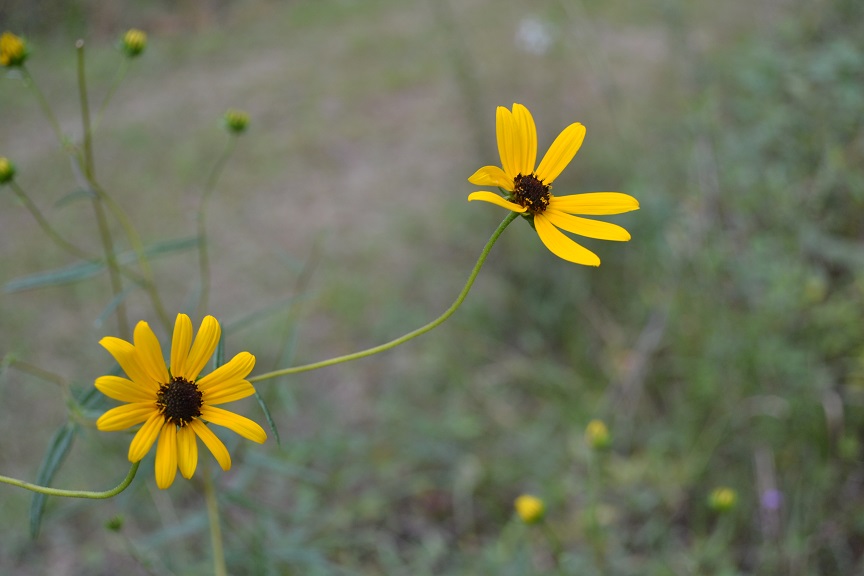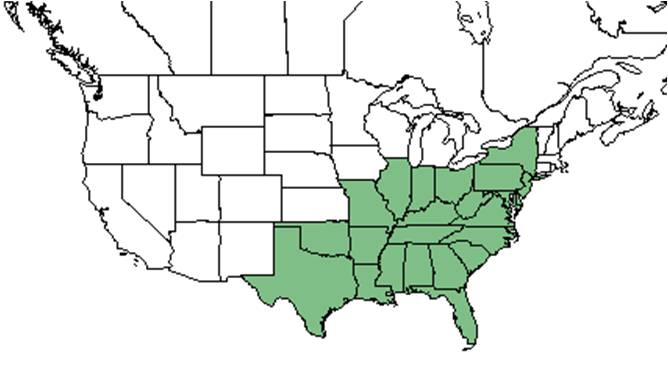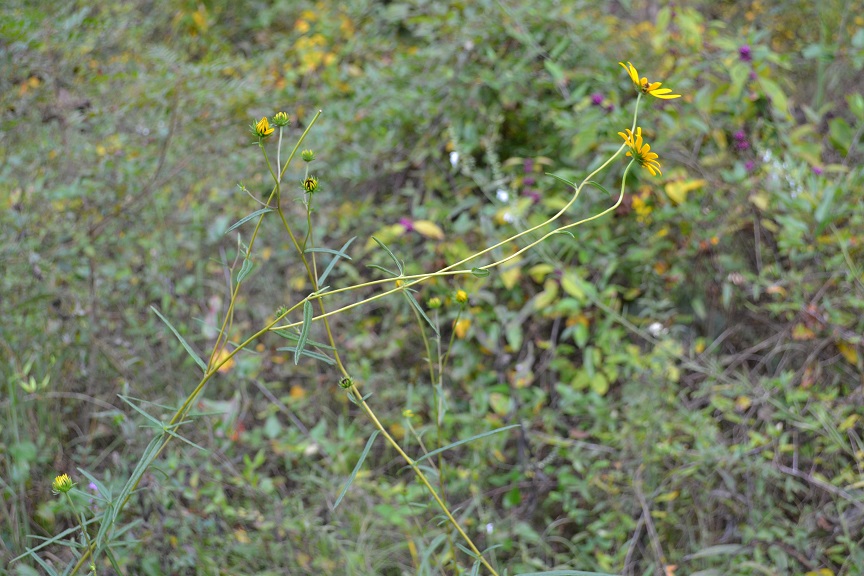Difference between revisions of "Helianthus angustifolius"
(→Pollination) |
|||
| Line 31: | Line 31: | ||
===Habitat=== <!--Natural communities, human disturbed habitats, topography, hydrology, soils, light, fire regime requirements for removal of competition, etc.--> | ===Habitat=== <!--Natural communities, human disturbed habitats, topography, hydrology, soils, light, fire regime requirements for removal of competition, etc.--> | ||
| − | Generally, this species is found in savannas, marshes, ditches, and other wet habitats.<ref name= "Weakley"/> It is also found in various floodplains and bottomlands, and prefers partial shade in a variety of soils including sandy, sandy loam, medium loam, clay loam, clay, and acid-based soils.<ref name= "lady bird"/> It is listed by the USDA Natural Resources Conservation Service as a facultative wetland species, where it is more often found in wetland habitats, but can also be found in non-wetland habitats.<ref name= "USDA"/> | + | Generally, this species is found in savannas, marshes, ditches, and other wet habitats.<ref name= "Weakley"/> It is also found in various floodplains and bottomlands, and prefers partial shade in a variety of soils including sandy, sandy loam, medium loam, clay loam, clay, and acid-based soils.<ref name= "lady bird"/> Habitats that ''Helianthus angustifolius'' has been observed in include sandy pinewoods, pine savannas, partially shaded mesic pine flatwoods, old field sites, open fields, dry ridges and ridge thickets, open banks of small streams, various low areas, pitcher plant bogs and swamps, swales, moors, pond banks, marsh margins, and others. It was also found to be tolerant of disturbances, since it was found in roadsides, along powerlines, and in clearcut areas. Other soils it was found growing on include muck and wet sands, and wet sandy peat.<ref name= "herbarium">Florida State University Robert K. Godfrey Herbarium database. URL: http://herbarium.bio.fsu.edu. Last accessed: May 2019. Collectors: Loran C. Anderson, Raymond Athey, Wilson Baker, Fred A. Barkley, C. Ritchie Bell, S. Bennett, Kurt E. Blum, S. Boyce, Ted Bradley, J. John Brady, K. Craddock Burks, A. F. Clewell, H. S. Conard, W. Cooper, D. S. Correll, Delzie Demaree, Wilbur H. Duncan, Joseph Ewan, G. Fleming, William B. Fox, P. Genelle, J. P. Gillespie, R. K. Godfrey, Rnady Haynes, Norlan C. Henderson, S. C. Hood, D. C. Hunt, S. B. Jones, Samuel B. Jones, Jr., Brian R. Keener, Lisa Keppner, Gary R. Knight, R. Komarek, R. Kral, H. Kurz, O. Lakela, S. W. Leonard, Peter S. Mathies, Sidney McDaniel, Herbert Monoson, J. Richard Moore, D. E. Moreland, John Morrill, John B. Nelson, R. A. Norris, Katelin D. Pearson, James D. Ray, Jr., P. L. Redfearn, Jr., L. L. Reese, W. D. Reese, H. F. L. Rock, M. Sears, L. H. Shinners, B. C. Tharpe, and Charles S. Wallis. States and Counties: Alabama: Baldwin, Limestone, Macon, Marion, Monroe, and Talladega. Arkansas: Drew, Greene, and Saline. Florida: Bay, Calhoun, Charlotte, Citrus, Duval, Flagler, Franklin, Gadsden, Gulf, Hernando, Hillsborough, Holmes, Jackson, Jefferson, Leon, Liberty, Pinellas, Polk, Santa Rosa, Taylor, Wakulla, Walton, and Washington. Georgia: Bartow, Brantley, Colquitt, Decatur, Grady, Seminole, and Thomas. Kentucky: Lyon. Louisiana: Lafayette, Morehouse, and Washington. Mississippi: Covington, Harrison, Lamar, and Oktibbeha. North Carolina: Brunswick, Cabarrus, Hertford, Person, and Robeson. Oklahoma: Sequoyah. Tennessee: Coffee, Cumberland, and Macon. South Carolina: Allendale and Orangeburg. Texas: Freestone, Galveston, Gonzales, Henderson, Robertson, and Van Zandt.</ref> It is listed by the USDA Natural Resources Conservation Service as a facultative wetland species, where it is more often found in wetland habitats, but can also be found in non-wetland habitats.<ref name= "USDA"/> |
| + | |||
| + | Associated species include ''Pinus taeda'', ''Pinus elliottii'',''Pinus palustris'', ''Carphephorus'' sp., ''Solidago stricta'', ''Rudbeckia'' sp., ''Liatris'' sp., ''Naccharis'' sp., ''Lobelia'' sp., ''Coelorachis rugosa'', ''Hyptis alata'', ''Vitis rotundifolia'', ''Rhexia'' sp., and grasses.<ref name= "herbarium"/> | ||
===Phenology===<!--Timing off flowering, fruiting, seed dispersal, and environmental triggers. Cite PanFlora website if appropriate: http://www.gilnelson.com/PanFlora/ --> | ===Phenology===<!--Timing off flowering, fruiting, seed dispersal, and environmental triggers. Cite PanFlora website if appropriate: http://www.gilnelson.com/PanFlora/ --> | ||
Revision as of 14:41, 21 May 2019
| Helianthus angustifolius | |
|---|---|

| |
| Photo taken by Kevin Robertson | |
| Scientific classification | |
| Kingdom: | Plantae |
| Division: | Tracheophyta- Vascular plants |
| Class: | Magnoliopsida - Dicotyledons |
| Order: | Ericales |
| Family: | Ericaceae |
| Genus: | Helianthus |
| Species: | H. angustifolius |
| Binomial name | |
| Helianthus angustifolius L. | |

| |
| Natural range of Helianthus angustifolius from USDA NRCS Plants Database. | |
Common names: swamp sunflower; swamp sneezeweed; narrowleaf sunflower
Contents
[hide]Taxonomic notes
Synonyms: Helianthus angustifolius L. var. angustifolius; H. angustifolius L. var. planifolius Fernald
Description
A description of Helianthus angustifolius is provided in The Flora of North America. Flowers are usually about 2 inches in diameter, and overall size class of the plant is between 1 and 3 feet tall.[1]
Distribution
Helianthus angustifolius is mostly found along the southeastern coastal plain, but is distributed from Long Island, New York south to central peninsular Florida and west to Texas, as well as irregularly inland up to Ohio, Missouri, and Indiana.[2]
Ecology
Habitat
Generally, this species is found in savannas, marshes, ditches, and other wet habitats.[2] It is also found in various floodplains and bottomlands, and prefers partial shade in a variety of soils including sandy, sandy loam, medium loam, clay loam, clay, and acid-based soils.[1] Habitats that Helianthus angustifolius has been observed in include sandy pinewoods, pine savannas, partially shaded mesic pine flatwoods, old field sites, open fields, dry ridges and ridge thickets, open banks of small streams, various low areas, pitcher plant bogs and swamps, swales, moors, pond banks, marsh margins, and others. It was also found to be tolerant of disturbances, since it was found in roadsides, along powerlines, and in clearcut areas. Other soils it was found growing on include muck and wet sands, and wet sandy peat.[3] It is listed by the USDA Natural Resources Conservation Service as a facultative wetland species, where it is more often found in wetland habitats, but can also be found in non-wetland habitats.[4]
Associated species include Pinus taeda, Pinus elliottii,Pinus palustris, Carphephorus sp., Solidago stricta, Rudbeckia sp., Liatris sp., Naccharis sp., Lobelia sp., Coelorachis rugosa, Hyptis alata, Vitis rotundifolia, Rhexia sp., and grasses.[3]
Phenology
H. angustifolius has been observed flowering in July, and September to November.[5] It is considered very showy along roadsides when it is in flower, especially in October.[2]
Seed dispersal
This species is thought to be dispersed by wind. [6]
Pollination
The plant is considered by pollination ecologists to be of special value to native bees since it attracts such large numbers for pollination.[1] It is also pollinated by insects, mostly flies but also beetles, and Lepidoptera species.[7]
Use by animals
It consists of approximately 5-10% of the diet for various large mammals, small mammals, and terrestrial birds.[8]
Conservation and management
It is listed as threatened by the Illinois Department of Natural Resources, Endangered Species Protection Board, and by the New York Department of Environmental Conservation, Division of Land and Forests. As well, it is listed as extirpated by the Pennsylvania Department of Conservation and Natural Resources.[4] This species is also considered to be an exotic species in West Virginia.[7]
Cultivation and restoration
Photo Gallery
References and notes
- ↑ Jump up to: 1.0 1.1 1.2 [[1]] Lady Bird Johnson Wildflower Center. Accessed: May 21, 2019
- ↑ Jump up to: 2.0 2.1 2.2 Weakley, A. S. (2015). Flora of the Southern and Mid-Atlantic States. Chapel Hill, NC, University of North Carolina Herbarium.
- ↑ Jump up to: 3.0 3.1 Florida State University Robert K. Godfrey Herbarium database. URL: http://herbarium.bio.fsu.edu. Last accessed: May 2019. Collectors: Loran C. Anderson, Raymond Athey, Wilson Baker, Fred A. Barkley, C. Ritchie Bell, S. Bennett, Kurt E. Blum, S. Boyce, Ted Bradley, J. John Brady, K. Craddock Burks, A. F. Clewell, H. S. Conard, W. Cooper, D. S. Correll, Delzie Demaree, Wilbur H. Duncan, Joseph Ewan, G. Fleming, William B. Fox, P. Genelle, J. P. Gillespie, R. K. Godfrey, Rnady Haynes, Norlan C. Henderson, S. C. Hood, D. C. Hunt, S. B. Jones, Samuel B. Jones, Jr., Brian R. Keener, Lisa Keppner, Gary R. Knight, R. Komarek, R. Kral, H. Kurz, O. Lakela, S. W. Leonard, Peter S. Mathies, Sidney McDaniel, Herbert Monoson, J. Richard Moore, D. E. Moreland, John Morrill, John B. Nelson, R. A. Norris, Katelin D. Pearson, James D. Ray, Jr., P. L. Redfearn, Jr., L. L. Reese, W. D. Reese, H. F. L. Rock, M. Sears, L. H. Shinners, B. C. Tharpe, and Charles S. Wallis. States and Counties: Alabama: Baldwin, Limestone, Macon, Marion, Monroe, and Talladega. Arkansas: Drew, Greene, and Saline. Florida: Bay, Calhoun, Charlotte, Citrus, Duval, Flagler, Franklin, Gadsden, Gulf, Hernando, Hillsborough, Holmes, Jackson, Jefferson, Leon, Liberty, Pinellas, Polk, Santa Rosa, Taylor, Wakulla, Walton, and Washington. Georgia: Bartow, Brantley, Colquitt, Decatur, Grady, Seminole, and Thomas. Kentucky: Lyon. Louisiana: Lafayette, Morehouse, and Washington. Mississippi: Covington, Harrison, Lamar, and Oktibbeha. North Carolina: Brunswick, Cabarrus, Hertford, Person, and Robeson. Oklahoma: Sequoyah. Tennessee: Coffee, Cumberland, and Macon. South Carolina: Allendale and Orangeburg. Texas: Freestone, Galveston, Gonzales, Henderson, Robertson, and Van Zandt.
- ↑ Jump up to: 4.0 4.1 USDA, NRCS. (2016). The PLANTS Database (http://plants.usda.gov, 21 May 2019). National Plant Data Team, Greensboro, NC 27401-4901 USA.
- Jump up ↑ Nelson, G. PanFlora: Plant data for the eastern United States with emphasis on the Southeastern Coastal Plains, Florida, and the Florida Panhandle. www.gilnelson.com/PanFlora/ Accessed: 12 DEC 2016
- Jump up ↑ Kirkman, L. Katherine. Unpublished database of seed dispersal mode of plants found in Coastal Plain longleaf pine-grasslands of the Jones Ecological Research Center, Georgia.
- ↑ Jump up to: 7.0 7.1 [[2]] NatureServe Explorer. Accessed: May 21, 2019
- Jump up ↑ Miller, J.H., and K.V. Miller. 1999. Forest plants of the southeast and their wildlife uses. Southern Weed Science Society.

